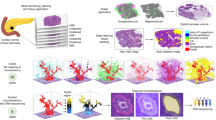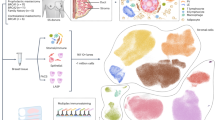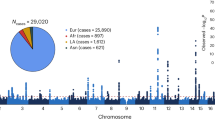Abstract
Many tumour types have been reported to have deletion of 9p21 (rets 1-6). A candidate target suppressor gene, p16 (p16INK4a/MTS-1/CDKN2), was recently identified within the commonly deleted region in tumour cell lines7,8. An increasing and sometimes conflicting body of data has accumulated regarding the frequency of homozygous deletion and the importance of p16 in primary tumours. We tested 545 primary tumours by microsatellite analysis with existing and newly cloned markers around the p16 locus. We have now found that small homozygous deletions represent the predominant mechanism of inactivation at 9p21 in bladder tumours and are present in other tumour types, including breast and prostate cancer. Moreover, fine mapping of these deletions implicates a 170 kb minimal region that includes p16 and excludes p15.
This is a preview of subscription content, access via your institution
Access options
Subscribe to this journal
Receive 12 print issues and online access
$209.00 per year
only $17.42 per issue
Buy this article
- Purchase on Springer Link
- Instant access to full article PDF
Prices may be subject to local taxes which are calculated during checkout
Similar content being viewed by others
References
Diaz, M.O. et al. Deletions of interferon genes in acute lymphoblastic leukemia. N. Engl. J. Med. 332, 77–82 (1990).
Fountain, J.W. et al. Homozygous deletions within human chromosome band 9p21 in melanoma. Proc. natn. Acad. Sci. U.S.A. 89, 10557–10561 (1992).
James, C.D. et al. Chromosome 9 deletion mapping reveals interferon a and interferon β-1 gene deletions in human glial tumors. Cancer Res. 51, 1684–1688 (1991).
Olopade, O.I. et al. Homozygous loss of the interferon genes defines the critical region on 9p that is deleted in lung cancers. Cancer Res. 53, 2410–2415 (1993).
Cairns, P., Tokino, K., Eby, Y. & Sidransky, D. Homozygous deletions of 9p21 in primary human bladder tumors detected by comparative multiplex polymerase chain reaction. Cancer Res. 54, 1422–1424 (1994).
van der Riet, P. et al. Frequent loss of chromosome 9p21 -22 early in head and neck cancer progression. Cancer Res. 54, 1156–1158 (1994).
Kamb, A. et al. A cell cycle regulator potentially involved in genesis of many tumor types. Science 264, 436–440 (1994).
Nobori, T. et al. Deletions of the cyclin-dependent kinase-4 inhibitor gene in multiple human cancers. Nature 368, 753–756 (1994).
Knudson, A.G., Jr., Hethcote, H.W. & Brown, B.W. Mutation and childhood cancer: a probabilistic model for the incidence of retinoblastoma. Proc. natn. Acad. Sci. U.S.A. 72, 5116–5120 (1975).
Hussussian, C.J. et al. Germline p16 mutations in familial melanoma. Nature Genet. 8, 15–21 (1994).
Mori, T. et al. Frequent somatic mutation of the MTS1/CDK4I (multiple tumor suppressor/cyclin-dependent kinase 4 inhibitor) in esophageal squamous cell carcinoma. Cancer Res. 54, 3396–3397 (1994).
Caldas, C. et al. Frequent somatic mutations and homozygous deletions of the p16 (MTS1) gene in pancreatic adenocarcinoma. Nature Genet 8, 27–32 (1994).
Hayashi, N., Sugimoto, Y., Tsuchiya, E., Ogawa, M. & Nakamura, Y. Somatic mutations of the MTS1 (multiple tumor suppressor) CDK41 (cyclin-dependent kinase-4 inhibitor) gene in human primary non-small cell lung carcinomas. Biochem. biophys. Res. Commun. 202, 1426–1430 (1994).
Kamb, A. et al. Analysis of the p16 gene (CDKA/2) as a candidate for the chromosome 9p melanoma susceptibility locus. Nature Genet. 8, 23–26 (1994).
Xu, L. et al. Rarity of somatic and germline mutations of the cyclin-dependent kinase 4 inhibitor gene, CDK4I, in melanoma. Cancer Res. 54, 5269–5272 (1994).
Zhou, X. et al. The MTS1 gene is frequently mutated in primary human esophageal tumors. Oncogene 9, 3737–3747 (1994).
Okamoto, A. et al. Mutations in the p16(INK4)/MTS1/CDKN2,p15(INK4B)/ MTS2, and p18 genes in primary and metastatic lung cancer. Cancer Res. 55, 1448–1451 (1995).
Cairns, P. et al. Rates of p16(MTS1) mutations in primarytumors with 9p loss. Science 265, 415–416 (1994).
Xu, L., et al. Mutational analysis of CDKN2 (MTS1/P16INK4) in human breast carcinomas. Cancer Res. 54, 5262–5264 (1994).
Jen, J. et al. Deletion of p16 and p15 genes in brain tumors. Cancer Res. 54, 6353–6358 (1994).
Middleton-Price, H., Spurr, N., Hall, A. & Malcolm, S. N-ras-like sequences on chromosomes 9,6 and 22 with a polymorphism at the chromosome 9 locus. Ann. hum. Genet. b, 189–195 (1988).
Sauter, G. et al. Chromosome-9 loss detected by fluorescence in situ hybridization in bladder cancer. Int. J. Cancer 64, 99–103 (1995).
Kamb, A., Liu, Q., Harshman, K. & Tavtigian, S. Rates of p16(MTS1) mutations in primary tumors with 9p loss. Science 265, 416–417 (1994).
Lefebvre, S. et al. Identification and characterization of a spinal muscular atrophy-determining gene. Cell 80, 155–165 (1995).
Roy, N. et al. The gene for neuronal apoptosis inhibitory protein is partially deleted in individuals with spinal muscular atrophy. Cell 80, 167–178 (1995).
Cairns, P., Shaw, M.E. & Knowles, M.A. Initiation of bladder cancer may involve deletion of a tumor suppressor gene on chromosome 9. Oncogene 8, 1083–1085 (1993).
Merlo, A., et al. CpG island methylation is associated with transcriptional silencing of the tumour suppressor CDKN2/p16 in human cancers. Nature Med. 1, 686–692 (1995).
Weaver-Feldhaus, J. et al. Localization of a putative tumor suppressor gene by using homozygous deletions in melanomas. Proc. natn. Acad. Sci. U.S.A. 91, 7563–7567 (1994).
Zhang, J., Meltzer, P., Jenkins, R., Guan, X.Y., Trent, J. Application of chromosome microdissection probes for elucidation of BCR-ABL fusion and variant Philadelphia chromosome translocations in chronic myelogenous leukemia. Blood 81, (12), 3365–3371 (1993).
Author information
Authors and Affiliations
Rights and permissions
About this article
Cite this article
Cairns, P., Polascik, T., Eby, Y. et al. Frequency of homozygous deletion at p16/CDKN2 in primary human tumours. Nat Genet 11, 210–212 (1995). https://doi.org/10.1038/ng1095-210
Received:
Accepted:
Issue Date:
DOI: https://doi.org/10.1038/ng1095-210
This article is cited by
-
Novel genomic alteration in superficial esophageal squamous cell neoplasms in non-smoker non-drinker females
Scientific Reports (2021)
-
Primary sclerosing cholangitis and the risk of cancer, cardiovascular disease, and all-cause mortality: a systematic review and meta-analysis of cohort studies
Scientific Reports (2021)
-
The Pivotal Role of Senescence in Cell Death and Aging: Where Do We Stand?
Current Molecular Biology Reports (2020)
-
Prognostic significance of p16 immunohistochemical expression in urothelial carcinoma
Surgical and Experimental Pathology (2019)
-
Senescent cells: an emerging target for diseases of ageing
Nature Reviews Drug Discovery (2017)



